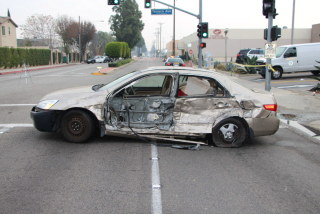Toyota settles suit over deadly wreck
- Share via
Toyota Motor Corp. has quietly settled a high-profile lawsuit over a fatal crash near San Diego last year that drew national attention to sudden acceleration in its vehicles and led to massive recalls and an unprecedented apology from its president.
The automaker revealed the settlement in a letter to a California Superior Court judge, but declined to provide any details of the terms, which it is seeking to keep confidential.
By getting the case off its growing plate of legal woes, Toyota can focus on an aggressive strategy to fend off lawsuits with less dramatic evidence, many of which point to potential electronic problems in vehicles.
But the settlement has left out co-defendant Bob Baker Lexus, a move by the automaker that could set the stage for a potentially bloody fight with its own dealers over who is to blame for sudden acceleration incidents.
“Toyota has sought to protect only its own interests. They decided to cut out their own dealer,” said Larry Willis, attorney for Bob Baker Lexus, which lent the ill-fated Lexus ES to California Highway Patrol officer Mark Saylor in August 2009.
Saylor was killed, along with his wife, Cleofe Lastrella, 13-year-old daughter, Mahala, and brother-in-law Chris Lastrella, when the sedan sped out of control and crashed over an embankment.
Investigators said the crash may have been caused by an improperly installed floor mat, but Willis argues that the floor mat was not the problem. He said the accident could have been caused by an inherent defect in the car’s electronics.
The suit, filed by Saylor’s parents along with the parents of his wife and brother-in-law, was considered by far the strongest among the hundreds of sudden acceleration cases brought against Toyota in the last year.
“Until they got rid of this case, it was going to be something everyone pointed at Toyota for,” said Don Slavik, an attorney representing plaintiffs in sudden acceleration cases filed against the automaker in both federal and state court. “Now they’re going to argue this was the dealer’s fault alone and their cars aren’t defective.”
Bolstered by a 911 recording of the victims screaming “there’s no brakes!” moments before a fiery death, the accident set off a chain of events leading to congressional hearings, multiple federal investigations and record fines against the automaker.
On Monday afternoon, Toyota is expected to file motions with Superior Court Judge Anthony J. Mohr in Santa Ana disclosing the settlement and requesting that its details be kept confidential, Willis said.
“Toyota and the Saylor and Lastrella families reached an amicable agreement in mediation that fully resolves their product liability claims against Toyota,” the automaker said in a statement Friday.
Court filings indicate that Toyota and the plaintiffs negotiated a settlement in early June.
Willis said that because the terms of the Saylor settlement could have a material effect on the outcome of his client’s defense, he will oppose the request for confidentiality.
“Our concern is that the dealership’s interests have not been protected by Toyota,” he said.
An individual involved in the mediation and who asked for anonymity said the plaintiffs had requested a $10-million settlement.
The automaker still faces dozens of other personal injury suits in that courtroom, as well as federal personal injury suits and claims for economic damage that have been consolidated in a U.S District Court in Santa Ana. Many of the other suits name Toyota dealers as co-defendants.
This week, Toyota filed a motion to dismiss hundreds of the federal complaints seeking class action status on grounds that they failed to identify a single electronic defect that could cause sudden acceleration.
Tim Pestotnik, an attorney for the Saylor and Lastrella families, declined to comment on the settlement and would not discuss his plans for the suit against Bob Baker Lexus. John L. Saylor, father of Mark Saylor, said he could not discuss settlement negotiations.
According to Willis, the plaintiffs’ claim of negligence against Bob Baker Lexus has not been dropped.
Aaron Jacoby, a Los Angeles attorney specializing in representing dealerships, said it was rare for dealers and automakers to break ranks in litigation in which both are defendants.
“There is usually a standard of cooperation, but Toyota is not fighting just one case. There is a lot of money at stake,” Jacoby said. “It absolutely means that other dealers should be very careful going forward.”
Toyota has roughly 1,200 dealers nationwide.
Although hundreds of sudden acceleration complaints and multiple federal investigations of the phenomenon had been logged before Aug. 28, 2009, it wasn’t until the Saylor crash that the issue took on national significance.
Saylor, 45, had taken his Lexus to the dealership for servicing and was lent a Lexus ES. Shortly thereafter, the car accelerated out of control on the suburban San Diego freeway, eventually crashing into a sport utility vehicle and over an embankment, bursting into flames.
The occupants’ panicked cries for help were captured on a 911 call that was replayed around the country and set off alarm bells within Toyota.
Three days after the accident, an internal Toyota e-mail warned of repercussions from regulators because of the accident, on grounds that in the U.S., “killing a police officer means the death penalty.” That e-mail was filed in federal court last month.
Less than a month later, Toyota announced the first of what would become a string of recalls, for 3.8 million Lexus and Toyota vehicles with floor mats that it claimed could be entrapped by the accelerator pedal. Since then, Toyota has issued more than 7 million additional recall notices.
An investigation by the California Highway Patrol found that the wrecked sedan had floor mats from a Lexus SUV, which were larger and increased the chances of pedal entrapment. In addition, the report showed that the dealership had only days earlier received a complaint from another customer about sudden acceleration in the same vehicle because of a sticking mat.
The report, released in December, suggested that the mat probably was the cause of the accident, but because the fire damage was so severe, an electronic or mechanical problem could not be excluded.
Meanwhile, the Saylor accident had become the focal point of a growing outcry over Toyota’s sudden acceleration problems.
The furor reached a peak in late February, when Fe Lastrella, mother of victims Cleofe and Chris, broke down in tears during a congressional hearing just hours after Toyota President Akio Toyoda testified that he was “deeply sorry” for accidents in Toyota vehicles.
The next week, the Saylor and Lastrella families filed suit against Toyota in California Superior Court, seeking compensation from Toyota and the dealership for their loss.
In the spring, the dealership filed a cross-complaint against Toyota, arguing that the automaker should be liable for any defects inherent in the vehicle.
By excluding Bob Baker Lexus from the settlement, Toyota appears to be taking the position that the fault in the accident lies entirely with the dealership for putting in the wrong floor mat.
Last fall, Toyota argued that there is no problem with its cars so long as the mats are correctly installed, a posture that has been criticized by Congress and the National Highway Traffic Safety Administration. That agency took the unusual step last November of rebuking Toyota for alleging that “no defect exists” in its vehicles.
Willis argues that the floor mat could not have caused the accident because the incident was of such long duration, nearly two minutes, that Saylor would have been able to free the mat. Allying himself, surprisingly, with many of Toyota’s critics, he instead argues that the problem was electronic in nature.
What’s more, he said, the vehicle lacked a brake override, a safety feature that Toyota had discussed implementing a full two years before the Saylor crash, but decided against. This year, Toyota said it would install brake override on all its vehicles in the future.
“We view this as 100% a problem of the design of the vehicle,” Willis said.
Jacoby, the attorney for dealers, said he was worried that Toyota’s decision to leave Bob Baker Lexus out in the cold could have ramifications beyond the courtroom.
“The bigger problem for Toyota is an image problem,” he said






